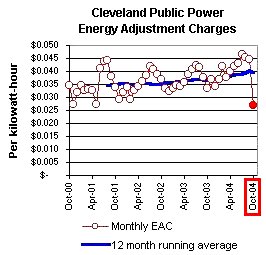The bill would normally have been a little lower this month because we're back in Winter rate season. But the unexpected change was a drop in the "energy adjustment charge" -- the part of the bill that fluctuates monthly with CPP's cost of purchased power -- from four and a half cents per kwh, where it's been all Summer, to 2.7 cents. Sha-zam! My bill for about 500 kwh got $8 cheaper, and I owe CPP about 10% less than a CEI customer with the same usage.
The "EAC", which is broken out on the bill, is a very big factor in CPP's monthly charges because the system gets virtually all of its power supply from other utilities, generating only a thin margin of its own peak usage with some gas turbines. To get an idea of the scale of this cut in Public Power's EAC, take a look at this chart:

The red dot dangling at the right end of the graph line is the EAC for October. A big dropoff, yes? Sort of like the price of unleaded regular going back to $1.40 a gallon.
But just as the price of gasoline is only part of the cost of running your car, the cost of purchased power is only part of CPP's rates. Taking a cent and a half off the EAC still leaves Public Power customers paying a Winter rate of 9.7 cents a kilowatt-hour (10.9 cents in the Summer). While that's noticeably cheaper than CEI and its First Energy partners, Ohio Edison and Toledo Edison, it's still more expensive than any other private or municipal electric company in Ohio.
And it probably won't last very long.
I called Public Power yesterday and asked to speak with someone who could explain why their October EAC was so much lower, and what consumers can look forward to. I ended up leaving a message for James Quayle, whose title (I think) is CPP's Deputy Commissioner for Finance. A few minutes later the phone rang. On the other end was Julius Ciaccia, the City's Public Utilities Director, along with Quayle and his boss, CPP Commissioner James Majer. I guess getting quoted in Crain's raises your profile. (Actually they seem to have asked around and were told I'm not a nut case, which is gratifying.)
I learned several things from the call, which I'll try to follow up and share, but here are the main things Quayle and Majer told me about the October price cut:
1) CPP gets its purchased power from established contracts with nine other utilities, one of which is American Electric Power. (They don't buy power on short term "spot" contracts.)(Of course this doesn't explain why the EAC has been rising steadily for years -- see the "12 month running average" line on the chart above. That's a question for future discussion.)
2) During the last few months, their average power cost was pushed up because electricity sales were lower than expected. Power contracts involve fixed as well as variable charges. CPP's summer contract with AEP, for example, obligates the City to pay for a certain minimum power load whether it's fully used or not. Because the summer wasn't very hot, CPP sold less electricity than it projected, so those fixed charges were distributed among fewer kilowatt-hours and had a bigger price impact than they expected. When the summer season ended in October, contract obligations lined up better with sales, CPP was able to use its cheapest sources, and the average cost came down a lot -- hence a much lower EAC on my November bill.
3) The big reduction in averaqe power costs on the current bill probably won't last very long -- at least Majer and Quayle aren't willing to predict that it will. Majer said the current low EAC may last until December. After that, expect bills to rise again, though not necessarily to the record levels of the last few months.Bottom line: My "low" Public Power bill for October probably represents the bottom end of what CPP can charge me under the current rate structure. It's going to trend up again soon. But even at the low end, while CPP is a little cheaper than CEI/First Energy, it remains one of the most expensive sources of home electricity in Ohio.
The CPP managers promised to meet with me soon to talk more about the system's rates and other issues, short and long term. I'll let you know what else I learn.